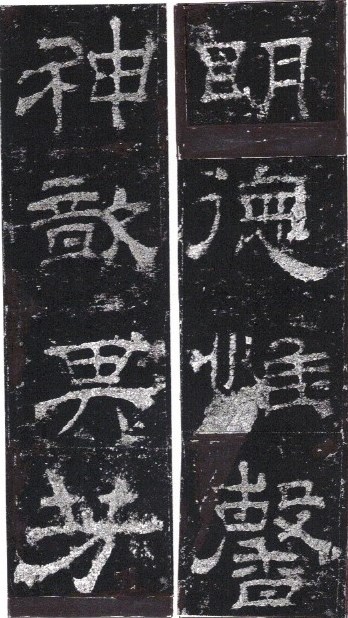
Mount Hua (華山) is located near the city of Huayin (華陰市) in Shaanxi (陕西) Province, about 120 kilometres east of Xi’an (西安). It is the Western Mountain (西嶽) of the Five Great Mountains of China (五嶽) and has a long history of religious significance. Mount Hua has five main peaks, the highest of which is the South Peak at 2,153 metres. It is part of the Qinling (秦嶺) which divide not only northern and southern Shaanxi, but also China.




Huashan Miao bei 華山廟碑 (Stele of Mount Huashan Temple) is also simply known as or Huashan Bei 華山碑 (Stele of Mount Huashan). The full name is Xi Yue Huashan Miao Bei 西嶽華山廟碑. It was originally erected in 165 CE at a temple built on the top of Mount Hushan (華山), Huayin, Shaanxi province (陕西華陰). The stele carries a stone inscription that describes how ancient emperors offered sacrifices to heaven and earth on the mountains. The inscription records the name of the calligrapher Guo Xiangcha (郭香察). This is very unusual as most of the Han steles do not record the names of the calligraphers. The stele was destroyed in an earthquake in 1555.

The text of Huashan Miao bei 華山廟碑
《周禮職方氏》:「河南山鎮曰崋,謂之西嶽。」《春秋傳》曰:「山嶽則配天,乾巛(坤)定位,山澤通氣,雲行雨施,既成萬物,易之義也。」《祀典》曰:「日月星辰,所昭卬也,地理山川,所生殖也,功加於民,祀以報之。」《禮記》曰:「天子祭天地,及山川,歲徧(遍)焉,自三五迭興,其奉山川,或在天子,或在諸侯,是以唐虞疇咨四嶽,五歲壹巡狩,皆以四時之中月,各省其方,親至其山,柴祭燔燎。夏、商則未聞所損益,周鑒於二代,十有二歲,王巡狩殷國,亦有事于方嶽,祀以圭璧,樂奏六歌。」高祖初興,改秦淫祀。太宗承循,各詔有司,其山川在諸侯者,以時祠之。孝武皇帝修封禪之禮,恩登假之道,巡省五嶽,禋祀豐備,故立宮其下,宮曰集靈宮,壂曰存僊壂,門曰望僊門。仲宗之世,重使使者持節祀焉,歲一禱而三祠,後不承前。至於亡新,寖用丘虛,迄今垣趾營兆猶存。建武之元,事舉其中,禮從其省,但使二千石以歲時往祠,其有風旱,禱請祈求,靡不報應,自是以來,百有餘年,有事西巡,輒過亨祭,然其所立碑石,刻紀時事,文字摩滅,莫能存識,延熹四年七月甲子,弘農大(太)守安國亭侯汝南袁逢,掌崋嶽之主位,應古制修廢起頓,閔其若茲,深達和民事神之義,精通誠至礿祭之福,乃案經傳所載,原本所由,銘勒斯石,垂之于後,其辭曰:「巖巖西嶽,峻極穹蒼,奄有河朔,遂荒崋陽,觸石興雲,雨我農桑,資糧品物,亦相瑤光,崇冠二州,古曰雍梁,馮于豳岐,文武克昌,天子展義,巡狩省方,玉帛之贄,禮與岱亢,六樂之變,舞以致康,在漢中葉,建設宇堂,山嶽之守,是秩是望,侯惟安國,兼命斯章,尊修靈基,肅共壇場,明德惟馨,神歆其芳,遏禳凶札,揫斂吉祥,歲其有年,民說無疆。」
袁府君肅恭明神,易碑飾闕,會遷京兆尹,孫府君到,欽若嘉業,遵而成之,延熹八年四月廿九日甲子就。袁府君諱逢,字周陽,汝南女陽人。孫府君諱璆,字山陵,安平信都人。時令朱頡,字宣得,甘陵鄃人。丞張房,字少游,河南京⼈。左尉唐佑,字君惠,河南密⼈。主者掾崋陰王萇,字德長。京兆尹勅監都水掾霸陵杜遷市石,遣書佐新豐郭香察書,刻者潁川邯鄲公修蘇張,工部君遷。
Zhou Li·Zhifangshi (周禮·職方氏) said: ‘The most famous mountain in south of the Wei River is Huashan (華山), it is also called Xiyue (西嶽)’. Spring and Autumn Zuozhuan (春秋左傳) said: ‘The sky is high, only mountains can match it. Heaven and earth have set their positions, the qi (氣) of the universe flows between the mountains and swamps, the clouds move in the sky, and the rain runs on the earth, so all things are nourished and they flourished. This is the principle stated in the Yi (易).’
The Book of Rites (祀典) said, ‘The sun, moon and stars are what people look up to, and the earth, mountains and rivers are what people rely on for their survival. They serve the people, so they should be repaid with sacrifices.’ It also said ‘The Son of Heaven (天子 kings / emperors) offer sacrifices to heaven, earth, mountains and rivers once a year.’ Since the rise of the Three Sovereigns and Five Emperors (三皇五帝), the sacrifices to mountains and rivers were offered by the emperors and sometimes by the princes. Emperor Yao (帝堯) and Emperor Shun (帝舜) toured round their territories every five years and they offered burnt sacrifices on the mountains.
The Zhou Dynasty followed the traditions of the Xia (夏) and Shang (商) dynasties. Every twelve years, the emperor went to the mountains to offer sacrifices with gui bi (圭璧, jade), silk (帛) and music.
In the Western Han Dynasty (202 BCE – 9 CE), Emperor Gaozu (漢高祖) abolished the indiscriminate and excessive sacrifices of the Qin Dynasty (秦代). Emperor Wen (漢文帝) followed the system of Gaozu. He notified the relevant feudal lords of the territories of mountains and to send officials to offer sacrifices at regular intervals. Emperor Wu (漢武帝) practised the ritual of Feng Chan (封禪之禮, offering solemn sacrifices to Heaven and earth). He wanted to become an immortal and attached importance to the rituals of sacrifices on the mountains, building a palace at the foot of Mount Hua. Emperor Xuan (漢宣帝) sent officials to pray and offer sacrifices three times a year. Since then, the practice of sacrifices has not been carried on. In the Xinmang period (新莽, 9-23 CE), the palace and temples gradually fell into ruins.
In the Eastern Han Dynasty, Emperor Guangwu (光武帝)(reigned from 25 CE to 57 CE) advocated the rule of moderation and harmony (中庸和諧). He simplified the rituals but still sent officials to offer sacrifices every year to dispel disasters and plead for prosperity. Since then, for more than a hundred years, when the emperor traveled westward they always went up Mount Hua to offer sacrifices. The events were recorded on steles but the inscriptions on the steles eroded away and could not be read.
On the fourth year of Yanxi (延熹四年)(162 CE), the prefect of Hongnong County (弘農郡太守) Feng Yuan (袁逢) came to the territory. He initiated the project of repairing the palaces and the temple, offering sacrifices respectfully and solemnly. Yuan was later transferred to another post and the project was completed under the supervision of another official Sun Qiu (孫璆) on the eighth year of Yanxi (延熹八年)(165 CE). A stele was erected to commemorate the sacrifices and the contributions of Feng Yuan and others on the project.
Professor Peter Lam (林業强教授) did a huge amount of research work on Huashan Miao Bei. He meticulously made a comparative studies of the four versions of ink rubbings – Shunde (順德本), Zhangyuan (長垣本), Huayin (華陰本) and Siming (四明本). Together with high definition colour printing of the album of the Shunde version and other documentations, Professor Lam published a book on his research studies of the stele. The name of the book is listed in the Bibliography.

My copy of the stele
Famous calligraphers’ works on Huaha Miao Bei





Two phrases that struck me are 明德惟馨,神歆其芳。(Modern Chinese translation: 只有道德的精誠,才是神靈樂意享的祭獻). Only with moral sincerity is the sacrifice that the deities are willing to accept and enjoy.
These words emphasize the importance of ‘right moral behaviour’ above ‘ritual’. This is similar to some quotations from the Holy Bible,
‘For I desired mercy, and not sacrifice; and the knowledge of God more than burnt offerings’ (Hosea 6:6).
‘I desire mercy, not sacrifice.’ (Matthew 12:7)
Acknowledgements
I wish to thank Professor Peter Lam for his consistent support and guidance throughout the years and his two amazing books on Huashan Miao Bei.
Bibliography
https://en.wikipedia.org/wiki/Mount_Hua
https://www.1958xy.com/qz/toMActivity4ID/621b9b49bcaa4de2acea11c2d7e3e9ea?spm=1664020826945 中华文明的发祥地——华山 (a highly recommended video)
https://baike.baidu.com/item/%E5%8D%8E%E5%B1%B1%E7%A2%91/8866249
https://new.qq.com/omn/20210518/20210518A0F9BH00.html
https://kknews.cc/culture/34layna.html 經典碑帖釋文譯註——東漢《華山廟碑》(with translations into modern Chinese language)
林業强 (1977), 漢延熹西嶽華山廟碑, 香港中文大學中國文化,文物館藏品專刊之一,香港中文大學文物館
林業强 (1999), 漢延熹西嶽華山廟碑順德本 香港中文大學文物館藏品專刊之一,香港中文大學文物館,ISBN 962-7101-46X
梅原清山 (1983), 西嶽華山廟碑 書道技法講座《47》, 二玄社
松井如流 (1961), 西嶽華山廟碑 書跡名品叢刊 二玄社刊
高文 (1985) 漢碑集釋 河南大學出版社 (书号: 17435.001)
俞丰 (2009), 經典碑帖釋文譯注 上海書畫出版社 (ISBN 978-7-80725-846-9)
Ouyang Z S, W C Fong, Y F Wang (2008), Chinese Calligraphy, Yale University, ISBN 978-0-300-12107-0















